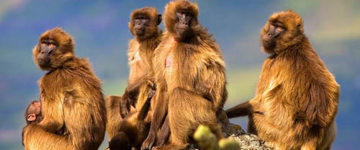Awash National Park
Lying in the lowlands east of Addis Ababa, and striding the Awash River, the Awash National Park is one of the finest reserves in Ethiopia. The Awash River, one of the major rivers of the Horn of Africa, waters important agricultural lands in the north-eastern part of Ethiopia and eventually flows into the wilderness of Danakil Depression.
The dramatic Awash Falls as the river tumbles into its gorge, is the site not to be missed in the national park. A special attraction is the beautiful clear pools of the hot springs (Filwoha).
Awash National Park, surrounding the dormant volcano of Fantale, is a reserve of arid and semi-arid woodland and savannah, with riverine forests along the Awash River. Forty-six species of animals have been identified here, including Beisa Oryx and Swayne's Hartebeest.
Facts
Awash National Park, 211 Kms east of Addis Ababa cover 756 square kilometers). The park takes its name from the Awash River which marks the park’s southern boundary. The rivers last gesture is the salt lake, Lake Abbe, on the Ethiopia-Djiboutian border.
The park offers quite good wildlife and outstanding birdlife viewing. It also contains an interesting range of volcanic landscapes. The Beisa Oryx and Sommering Gazelles – in the open areas, Greater and Lesser Kudus - in the bushed areas, the endemic Swayne’s Hartbeest – in the grass plains, the tiny salt Dik-Dik – under the dry acacia bushes and Defarsa waterbuck – in the bushy river area and the two monkey species – the Anubis and Hamadryas - can be seen near the river. Among other monkeys, Colobus and Grivet monkeys are found in the riverside and drier areas respectively. Leopards, Lions, Black-Backed and Golden Jackals, Caracals, Servals and Wildcats are also seen in the park very rarely.
Until recently, 2003, 462 bird species have been recorded. Of these six are endemics namely Banded Barbet, Golden-Backed Woodpecker, White-Winged Cliff Chat, White-Tailed Starling, Thick-Billed Raven and Wattled Ibis. There are several bustard species in the park and secretary birds in the grass plains. The camping grounds, near the bank of the Awash River, and the Filwoha Hot Spring areas are the best sites to spot many species of birds such as Emerald-Spotted Wood Dove, Green Wood-Hoopoes, Red and Yellow Barbets, Carmine Bea Eaters are to name only a few.
One of the main features of the park area is the Fentale Volcano, on the southern flank of which can be seen the dark scar of the last lava flow of 1820. The other feature is the turquoise-blue pools of the natural hot springs in the extreme north of the park where you can spot Waterbucks and Hamadryas baboons and sometimes hear Lions at night.


